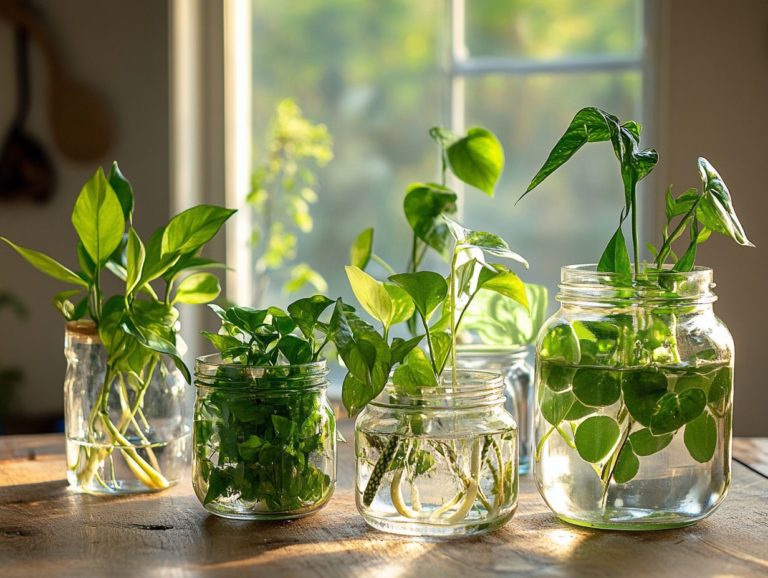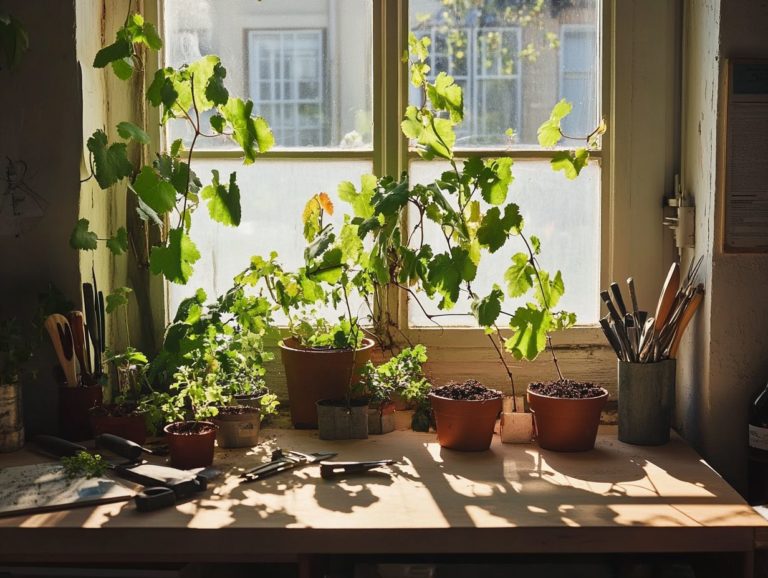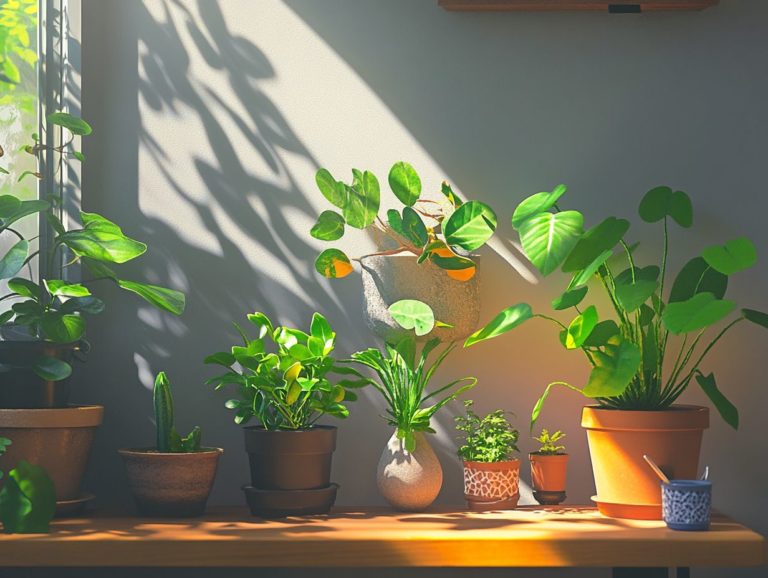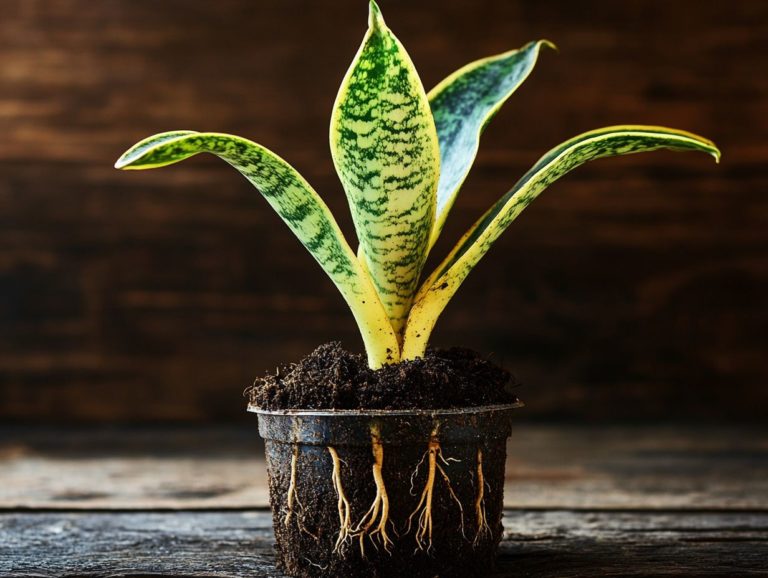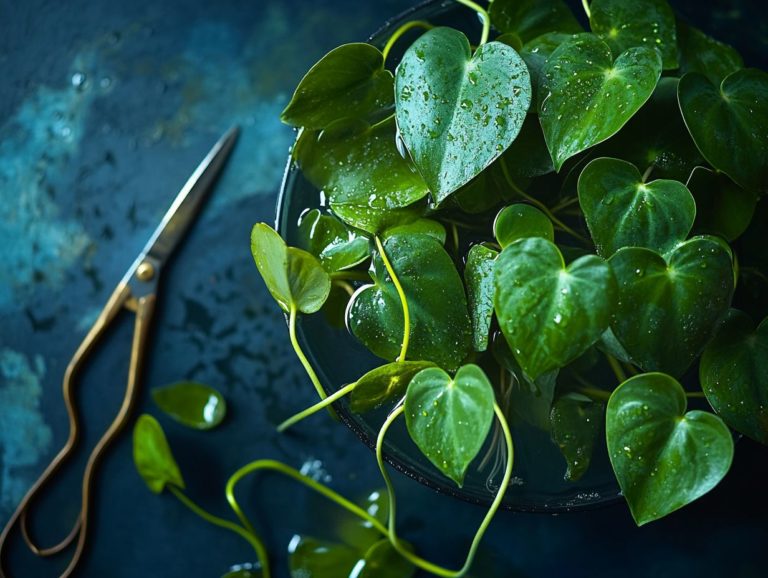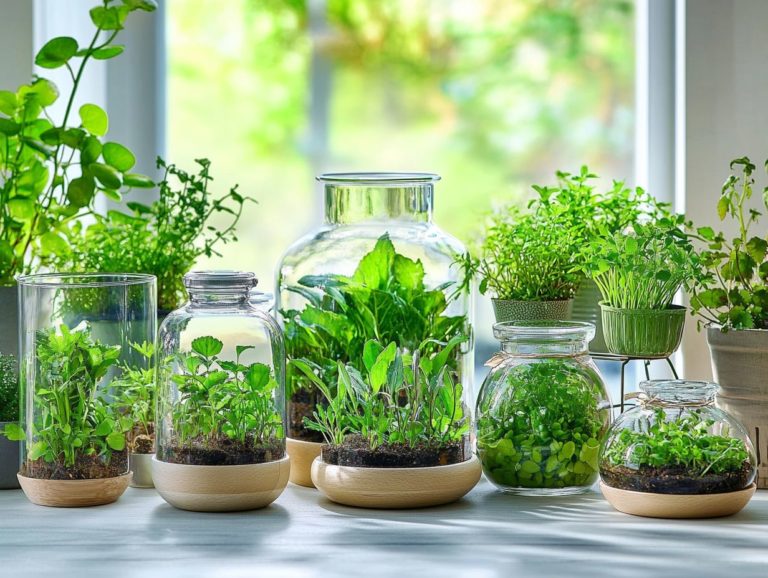How to Propagate Herbs Indoors
Growing herbs indoors offers countless advantages. It can elevate your dishes and provide fresh ingredients all year long. Not only does it enhance your space with vibrant greenery, but it also brings unmatched convenience and significant cost savings.
This guide will introduce you to the best herbs to cultivate within your home, outline the essential supplies you’ll need, and detail effective propagation methods, whether you’re starting from seeds or cuttings. You’ll also learn how to care for your indoor plants, with insightful tips on harvesting and making the most of those fresh flavors straight from your kitchen.
Get ready to transform your space into a vibrant herb paradise!
Contents
- Key Takeaways:
- Benefits of Growing Herbs Indoors
- Choosing the Right Herbs to Grow Indoors
- Supplies and Tools Needed for Indoor Herb Propagation
- Methods for Propagating Herbs Indoors
- Caring for Indoor Herbs
- Growing and Using Your Indoor Herbs
- Frequently Asked Questions
- What is the best way to propagate herbs indoors?
- Can I use any type of pot or container for propagating herbs indoors?
- Do I need to use any special soil for propagating herbs indoors?
- How often should I water my propagated herbs?
- When should I transplant my propagated herbs into a larger pot?
- Can I propagate herbs indoors all year round?
Key Takeaways:
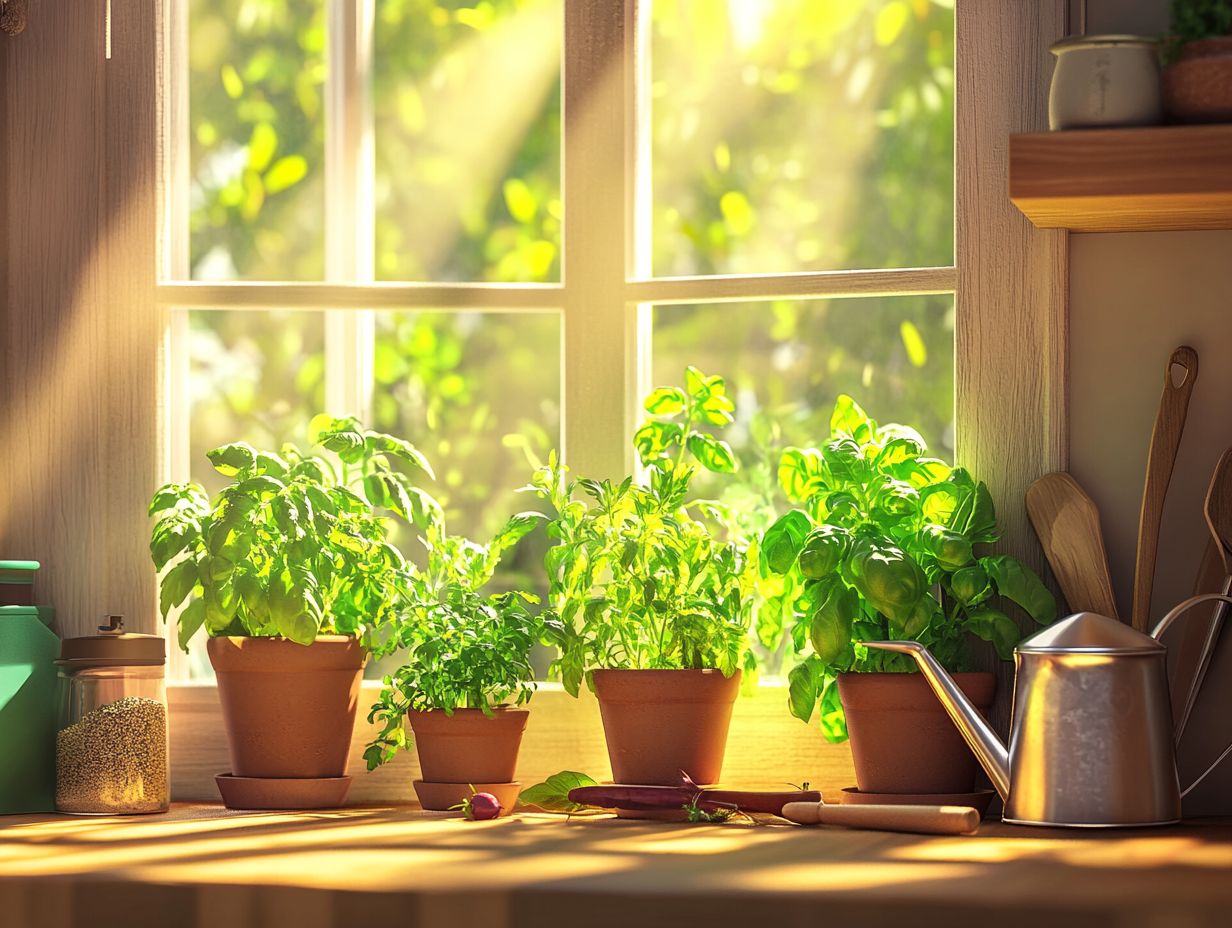
- Save time and money by growing herbs indoors, with the added convenience of having them readily available for cooking or medicinal purposes.
- Choose the best herbs for indoor growth, such as basil, mint, and thyme, which thrive in indoor environments and provide a variety of flavors and health benefits.
- Essential supplies for successful indoor herb propagation include containers, soil, and adequate lighting; methods can vary from seed germination to using cuttings from existing plants.
Benefits of Growing Herbs Indoors
Growing herbs indoors presents a wealth of benefits that transform your cooking experience into something truly rewarding, whether you re just starting out or have a green thumb. Cultivating fresh herbs year-round gives you easy access to vibrant ingredients that elevate your meals.
It also promotes wellness by providing fresh, nutritious options straight from your kitchen, ensuring that you always have high-quality ingredients at your fingertips. Establishing an indoor herb garden supports homegrown food production and lessens your reliance on store-bought herbs, which often lack flavor.
Convenience and Cost Savings
Growing herbs indoors enhances your cooking experience by offering unparalleled convenience and significant cost savings for both cooking enthusiasts and everyday home cooks.
Picture this: fresh herbs like parsley, thyme, and chives are just a snip away, rendering those frantic last-minute grocery trips nearly obsolete. You can effortlessly toss a handful of vibrant parsley into a salad or sprinkle fresh chives over comforting potatoes, all without the hassle of battling the aisles of a grocery store.
This easy access not only enhances the flavor profile of your meals but also inspires culinary creativity, inviting you to experiment with new recipes that tantalize your taste buds. Maintaining an indoor herb garden is easier than it appears; it requires minimal space and care, transforming your cooking endeavors into a more enjoyable and economical experience.
Choosing the Right Herbs to Grow Indoors
Selecting the right herbs to cultivate indoors is important for successful indoor gardening, elevating both your culinary adventures and overall gardening enjoyment.
Varieties such as basil, cilantro, and oregano each come with distinct growing requirements, significantly impacting your choices based on available space and your personal culinary tastes. By understanding these specific needs, including the best time to propagate your indoor plants, you can design an indoor herb garden perfectly suited to your kitchen’s unique conditions, ensuring a thriving and flavorful experience.
Best Herbs for Indoor Growth
Regarding indoor gardening, some of the finest herbs you can grow include basil, cilantro, rosemary, and thyme each bringing its own unique flair to your culinary creations.
Incorporating these herbs into your cooking can transform everything from simple pasta sauces to gourmet roasted meats, elevating your dishes to new heights. Basil flourishes in warm, sunlit spaces and needs regular watering to keep its vibrant, delicate leaves in top shape.
Cilantro prefers cooler temperatures and well-draining soil, making it an excellent choice for those with less intense light. Meanwhile, rosemary offers a hearty flavor and thrives on ample sunlight and infrequent watering, as it enjoys drier conditions.
Thyme is wonderfully versatile, fitting seamlessly into various cuisines, and flourishes with minimal water and plenty of light. To ensure these indoor herbs thrive, pay attention to proper ventilation and avoid overcrowding, which can stifle their growth.
Start your indoor herb garden today and enjoy fresh flavors at your fingertips!
Supplies and Tools Needed for Indoor Herb Propagation
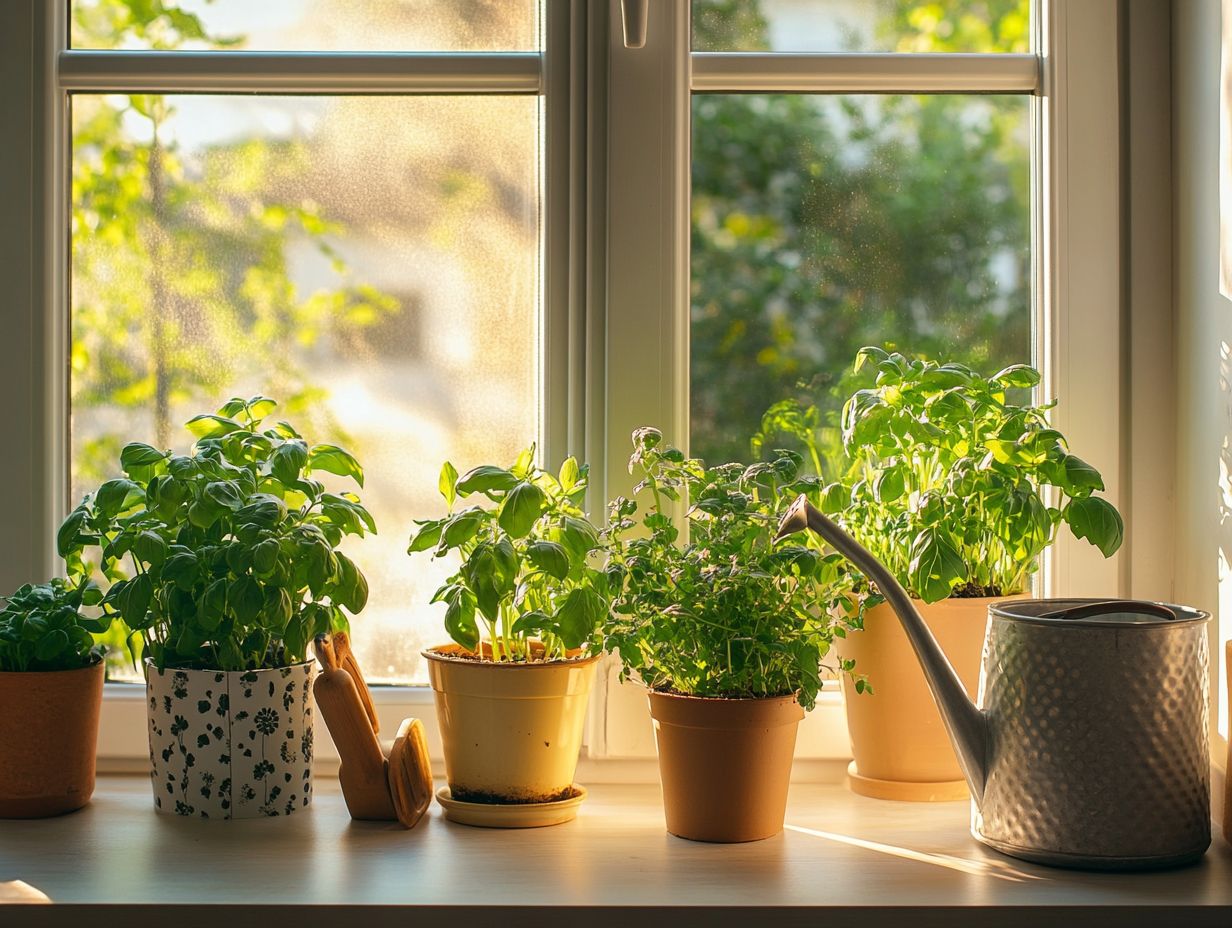
To successfully propagate herbs indoors, equipping yourself with the right supplies and tools is crucial for cultivating a thriving indoor garden that caters to their unique growing needs.
Essential items include:
- Containers with proper drainage holes
- High-quality potting soil (good soil retains moisture and provides nutrients)
- Possibly an LED grow light to enhance natural sunlight
These tools create optimal conditions for herb growth, ensuring your indoor garden thrives and gives you fresh herbs for your culinary creations.
Essential Items for Successful Growth
The essentials for cultivating a thriving indoor herb garden include containers, premium potting soil, and fertilizer made specifically for herbs.
Selecting the right containers is important; they should enhance your space aesthetically and have adequate drainage holes to prevent excess water from harming your plants by causing root rot, a condition where roots decay due to too much moisture.
High-quality potting soil is equally crucial, as it provides the nutrients and aeration necessary for your herbs to flourish. Opt for soil that retains moisture while allowing excess water to escape, keeping your roots healthy and happy.
Incorporating organic fertilizer is the final touch that guarantees your herbs receive the specific nutrients they need at every growth stage. This thoughtful selection of materials is vital for nurturing a lush and flavorful indoor herb garden, especially when you learn how to propagate your favorite houseplants.
Methods for Propagating Herbs Indoors
You have several methods at your disposal for propagating herbs indoors. The primary decision is whether to start from seeds or to use cuttings from established plants. Each approach offers unique advantages, allowing you to tailor your gardening experience to your preferences.
From Seed or Cuttings?
Choosing between seeds or cuttings will make your gardening adventure exciting and unique! Each method brings its own benefits and challenges that will influence growth.
For example, starting basil from seeds lets you enjoy nurturing the plant from the beginning. It requires warmth and well-drained soil for optimal germination, but be prepared for a waiting game, as it can take weeks for those little seeds to sprout.
On the flip side, propagating basil through cuttings is quicker and ensures you ll replicate the parent plant s characteristics, as long as the cuttings are taken properly and kept moist.
Cilantro, however, can be a bit tricky; it bolts quickly, presenting challenges with either method. You ll need to time your seed planting carefully to avoid this. Cuttings provide a more immediate solution but require consistent humidity and attentive care.
Caring for Indoor Herbs
Caring for indoor herbs requires understanding their distinct light, water, and nutrient needs. Grasping these essentials is important for fostering healthy plant growth.
Proper light exposure is critical; for instance, basil thrives under bright, direct sunlight, while parsley does well in partial shade. To enhance your indoor gardening experience, consider these lighting tips for indoor herb gardens. Your watering practices will also differ; herbs like rosemary prefer less frequent watering, while mint enjoys consistently moist soil.
Humidity control is another vital factor. Herbs such as cilantro thrive in higher humidity, while others may prefer drier conditions. Temperature preferences also vary; most herbs do best between 65 F to 75 F. Additionally, you can explore propagating indoor plants without soil to enhance your indoor gardening experience. Monitoring indoor temperatures is essential for cultivating healthy plants.
Balancing these elements will create a nurturing environment that encourages robust growth and enhances flavor. Don t wait! Start propagating your herbs today for a fresh supply of flavors in your kitchen!
Growing and Using Your Indoor Herbs
Using your indoor herbs with precision guarantees that you savor the freshest flavors while optimizing the yield of your herb garden.
Tips for Proper Harvesting and Storage
Proper harvesting techniques and storage methods are vital for preserving the flavor and longevity of your freshly harvested herbs.
When harvesting herbs, using sharp scissors or pruners for clean cuts is essential. This approach minimizes damage to the plant and encourages healthy growth. Aim to trim just above a leaf node the point on the stem where leaves grow. This little trick promotes bushier shoots that are a delight to work with.
After you’ve harvested, handle your herbs with care to maintain their delicate qualities. Storing them properly is just as important. For hardy herbs like rosemary and thyme, find a cool, dry spot. Soft herbs like basil and parsley benefit from being wrapped in a damp paper towel to keep them fresh longer. If you’re also interested in propagating succulents successfully, be sure to explore care techniques that can enhance your gardening skills.
The culinary possibilities are exciting! Imagine using your homegrown rosemary to season roasted meats. Or fresh basil to elevate pasta dishes. Don t wait! Start experimenting with your fresh herbs today.
Frequently Asked Questions
What is the best way to propagate herbs indoors?
The best way to propagate herbs indoors is by using stem cuttings. This involves taking a cutting from an existing herb plant and placing it in water or moist soil until it develops roots. While seeds and root division can also be used, stem cuttings tend to be the most successful.
Can I use any type of pot or container for propagating herbs indoors?
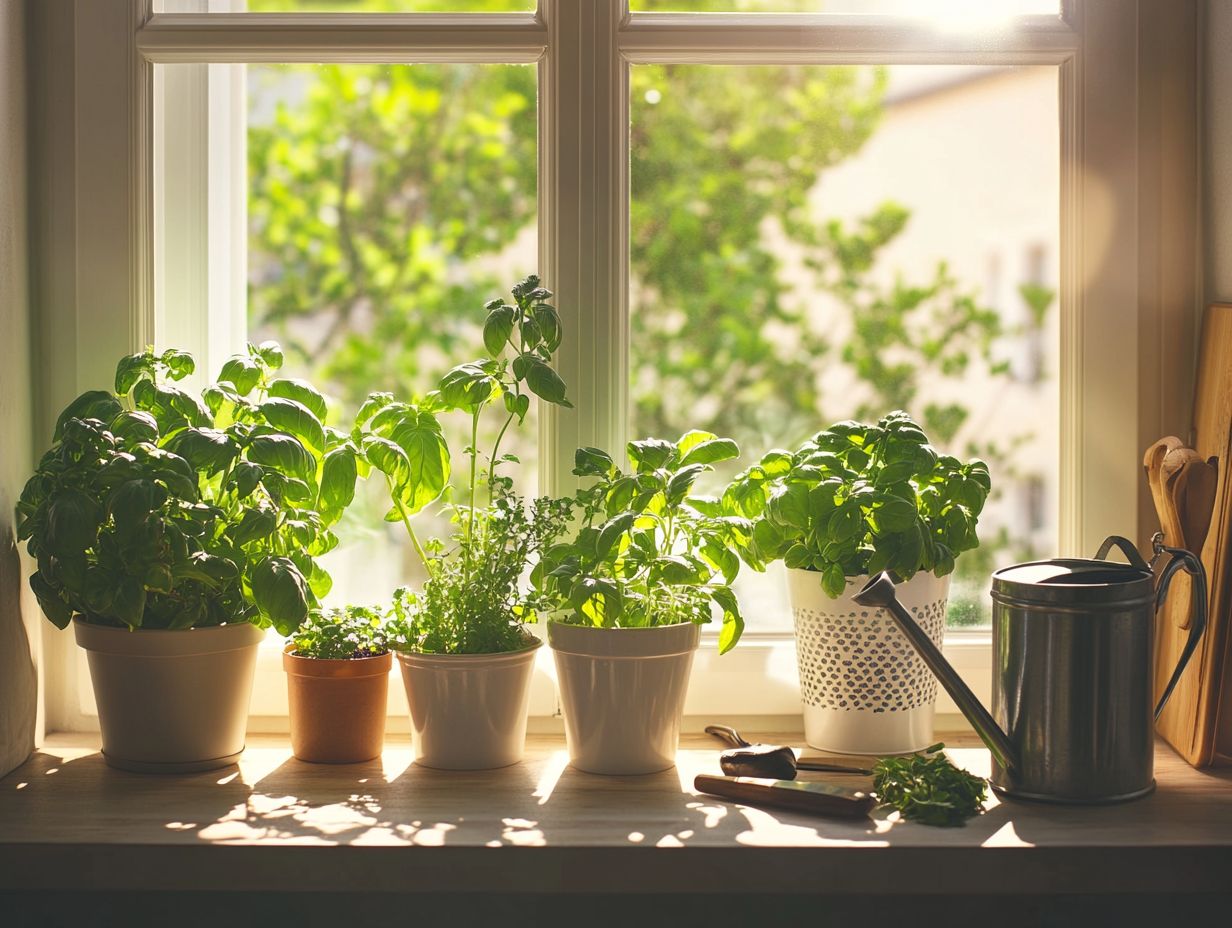
Yes, you can use any type of pot or container as long as it has good drainage. It’s important to choose a pot that is the appropriate size for the herb you are propagating and has proper drainage holes to prevent overwatering and root rot.
Do I need to use any special soil for propagating herbs indoors?
While you can use regular potting soil, it’s recommended to use a well-draining soil mix specifically for herbs. This type of soil provides the right balance of nutrients and moisture for the herb to grow healthy roots.
How often should I water my propagated herbs?
It’s important to keep the soil evenly moist, but not waterlogged, when propagating herbs indoors. This usually means watering every 1-2 days, but it’s best to check the soil moisture regularly and adjust watering accordingly.
When should I transplant my propagated herbs into a larger pot?
You can transplant your propagated herbs into a larger pot once they have developed a good root system and have outgrown their current container. This typically happens after 4-6 weeks, depending on the herb and growing conditions.
Can I propagate herbs indoors all year round?
Yes, you can propagate herbs indoors all year round as long as you provide the necessary growing conditions such as adequate light, proper temperature, and regular watering. Some herbs may have a slower growth rate during winter months, but they can still be propagated successfully.

